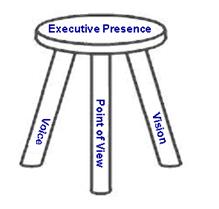Hello Leader,
Are you as eager today for your growth as you were when you started your professional journey?
If you are not developing as a person and a leader, you run the risk of becoming stale and losing interest. In this KEY we focus on executive presence. This executive development learning emerged in my meeting with a top talent group of highly committed managers. Please forward this KEY to friends, family and associates.
Sincerely,
Aviv Shahar
Executive Presence
"What is your top development objective as you look forward to the next three years?" was the question I asked a team of top talent managers. We came together to work on their personal and career development plans.
First, they each reflected on the three-story-house-framework analogy to identify their priorities. The ground floor is where you work in the business. The second floor is where you work on the business. And the third floor is where you work on you.
After they developed their priorities in each of these floors, we opened our coaching forum for each to dialogue with me in front of their peers on their top goals. The coaching forum provides great learning value as people are able to experience the hot seat and then watch their friends experience the hot seat, too.
"My top objective is to develop executive presence," said one manager who I will call here Tom. He was clear and focused, and his statement was captivating. It was evident he had thought about this hard and his choice to focus on developing executive presence represented a true need.
There is a difference between a true need and a contrived need. As a coach you learn to immediately sense when the person you are working with is speaking from a place of true need. You sense the energy potential, the "electricity," and there is an instant knowing that the articulation represents a delicious opportunity.
"Developing executive presence is a great goal. Your ability to actualize your goal is as good as your ability to identify the components of executive presence and then develop a concrete learning plan to build the elements of executive presence." I replied.
Tom did not hesitate. He was immediately all over it, thinking out loud about what constitutes executive presence. That's what I love about working with go-getters. Their impetus is never about being perfect; rather they demonstrate the immediacy of self-application. Great learners are people who never stop applying themselves to the next challenge. This is how they grow and differentiate. They always take the next step quickly to create movement, to build the momentum of their work and progress.
Here are the three Vs--the three legged stool-I offered Tom to build his learning plan to develop executive presence.

Voice: Finding your voice is the first leg. People pay attention when they feel that you speak in your own voice. Knowledge is power, and the greatest power in the world is self-knowledge. Getting to know yourself and finding your voice is the first leg of the executive presence stool.
No authenticity, no presence. If you don't know yourself and don't have the courage to show us who you are; if you don't know your strength and don't master your command of those assets, there is no foundation upon which to build executive presence.
Point of View: Developing a point of view is the second leg. To capture our attention you need to bring a unique perspective, an insight that adds value, a position and a point of view that clarifies options. You reason and equip us with new understandings and ways of looking at the problem; you frame distinct alternatives, and you offer your recommendations. You build an executive presence by offering these contributions and your point of view. We know what you value by what you lift up to our attention.
If you offer no new insight, add no new distinction, play it safe or are politically correct to conceal your point of view, people tune out. Executive presence is built by drawing to a point of focus the minds of the people you serve and lead. Their interest and engagement augments your executive presence.
Vision: Painting a vision is the third leg. You describe a picture of the future that pulls us in that direction. You tell a story that's inclusive; you address the needs and interests of the people around the table, and you offer a path forward to open possibilities we haven't seen before. You see a future, or a series of futures.
No energy potential and direction of movement, no presence. Executive presence manifests at the point where insight and meaning get translated into action and we begin to move and realize a future state you describe for us.
These are the three legs: Voice, Point of View, and Vision. Presence comes from your intent. The intentionality you bring to your presentation and express in your voice, point of view and vision is how you build your executive presence.
Now it's your turn. Turn the key. Find your voice. Develop a point of view. Paint a vision that compels your teams to act. Develop your executive presence and help create new futures for you and your clients.
© Aviv Shahar

